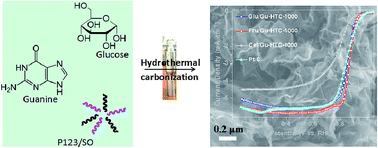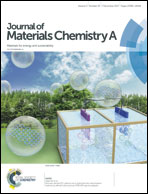Biomass derived 2D carbons via a hydrothermal carbonization method as efficient bifunctional ORR/HER electrocatalysts†
Abstract
Biomass derived carbons via hydrothermal carbonization (HTC) are critically important for different applications due to their low cost, eco-friendly properties, light weight and potential for the catalysis research field. However, standard HTC carbons commonly present amorphous and spherical morphology with low surface areas and large particle size. Here we report a 2D morphology of crystalline carbons via a HTC method by employing the biomolecule guanine and diverse carbohydrates (glucose, fructose and cellulose) as carbon precursors. Importantly, the addition of guanine to the HTC process plays a significant role in producing the 2D-morphology of carbon materials from the diverse carbohydrates. Hierarchical porous nitrogen-doped carbons with high surface areas up to 974 m2 g−1 and nitrogen contents as high as 2.39 at% are made by further high temperature carbonization. The current 2D carbons are found to be highly active toward the oxygen reduction reaction (ORR) with a rather positive half-wave potential of 0.87 V (vs. the RHE) and a large limiting current density of 5.9 mA cm−2. These catalysts outperform most other equivalent benchmarks as well as Pt-based electrocatalysts, meanwhile being efficient for the hydrogen evolution reaction (HER) with a very low overpotential of 0.35 V to achieve 10 mA cm−2 in alkaline medium. It is expected that our synthetic protocol can be extended to various bio-nucleobases, yielding all-sustainable bio-based electrocatalysts with a tunable structure, elemental composition, porosity and electronic properties.



 Please wait while we load your content...
Please wait while we load your content...